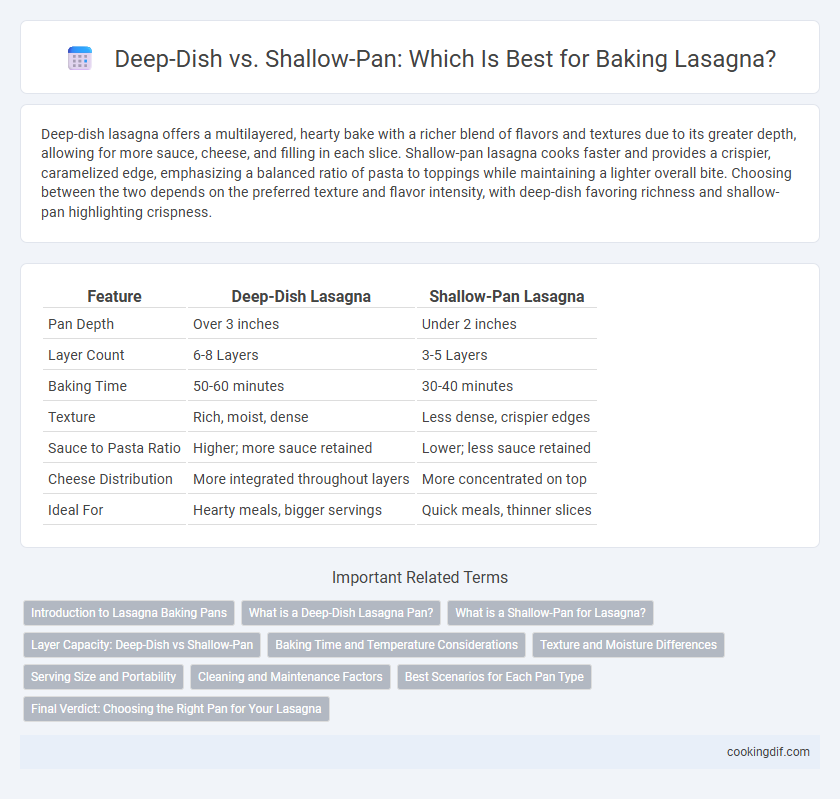Deep-dish lasagna offers a multilayered, hearty bake with a richer blend of flavors and textures due to its greater depth, allowing for more sauce, cheese, and filling in each slice. Shallow-pan lasagna cooks faster and provides a crispier, caramelized edge, emphasizing a balanced ratio of pasta to toppings while maintaining a lighter overall bite. Choosing between the two depends on the preferred texture and flavor intensity, with deep-dish favoring richness and shallow-pan highlighting crispness.
Table of Comparison
| Feature | Deep-Dish Lasagna | Shallow-Pan Lasagna |
|---|---|---|
| Pan Depth | Over 3 inches | Under 2 inches |
| Layer Count | 6-8 Layers | 3-5 Layers |
| Baking Time | 50-60 minutes | 30-40 minutes |
| Texture | Rich, moist, dense | Less dense, crispier edges |
| Sauce to Pasta Ratio | Higher; more sauce retained | Lower; less sauce retained |
| Cheese Distribution | More integrated throughout layers | More concentrated on top |
| Ideal For | Hearty meals, bigger servings | Quick meals, thinner slices |
Introduction to Lasagna Baking Pans
Choosing the right baking pan significantly impacts a lasagna's texture and cooking time, with deep-dish pans allowing for thicker layers and prolonged baking that enhances ingredient melding. Shallow-pan options promote faster cooking and more crispy edges, ideal for a balanced finish between tender interior and crunchy top. Both styles offer distinct benefits, making the pan selection crucial for achieving specific lasagna characteristics.
What is a Deep-Dish Lasagna Pan?
A deep-dish lasagna pan is typically 3 to 4 inches deep, designed to hold multiple layers of pasta, sauce, cheese, and fillings without overflowing during baking. This type of pan enables even heat distribution, ensuring thorough cooking and a perfectly set lasagna structure. Compared to shallow-pan lasagnas, deep-dish versions provide a heartier serving size and a more indulgent texture due to increased ingredient volume.
What is a Shallow-Pan for Lasagna?
A shallow-pan for lasagna typically measures around 1.5 to 2 inches deep, allowing for more even cooking and quicker baking times compared to deep-dish pans. Its reduced depth creates thinner layers, enhancing crisp edges and balanced texture throughout the dish. This pan type is ideal for those seeking a lighter, less dense lasagna with well-caramelized toppings and evenly melted cheese.
Layer Capacity: Deep-Dish vs Shallow-Pan
A deep-dish lasagna pan typically holds more layers of pasta, sauce, and cheese, allowing for a thicker, more substantial dish with pronounced stratification of flavors. Shallow-pan lasagnas tend to have fewer layers, resulting in a thinner casserole that cooks faster and offers a more balanced ratio of ingredients per bite. Choosing between deep-dish and shallow-pan affects not only the volume but the texture and baking time of the lasagna.
Baking Time and Temperature Considerations
Deep-dish lasagna requires longer baking times, typically around 60 to 75 minutes at 375degF, to ensure even cooking through its thick layers. Shallow-pan lasagna cooks faster, usually between 35 to 45 minutes at the same temperature, as heat penetrates more quickly due to the thinner profile. Adjusting baking time based on pan depth prevents undercooked centers or dry edges, optimizing texture and flavor balance.
Texture and Moisture Differences
Deep-dish lasagna typically offers a denser texture and retains more moisture due to its thicker layers, allowing sauces and cheeses to meld thoroughly during baking. Shallow-pan lasagna results in a crisper top layer and more pronounced caramelization, creating contrast between the sauce-soaked interior and the baked edges. The choice between deep-dish and shallow-pan directly affects the balance of creamy versus slightly crispy textures, influencing overall moisture distribution and flavor intensity.
Serving Size and Portability
Deep-dish lasagna typically yields larger, thicker servings, making it ideal for family-style meals where portion size is prioritized. Shallow-pan lasagna offers more uniform, thinner layers that enhance portability and ease of serving at gatherings or packed lunches. Choosing between deep-dish and shallow-pan depends on whether the focus is on hearty portions or convenient transportability.
Cleaning and Maintenance Factors
Deep-dish lasagna pans, often made of heavy-duty materials like cast iron or ceramic, offer excellent heat retention but require careful cleaning to prevent residue buildup and potential staining. Shallow-pan options, typically aluminum or non-stick coated, are easier to clean with standard dishwashing techniques, reducing scrubbing time and maintenance effort. Choosing the right pan for lasagna baking impacts long-term care, with deep-dish molds demanding more thorough cleaning to maintain durability.
Best Scenarios for Each Pan Type
Deep-dish pans excel when baking traditional, layered lasagna with thick sauce and abundant cheese, allowing flavors to meld during extended cooking times. Shallow-pan lasagna suits quick, evenly baked meals with thinner layers and less moisture, preventing sogginess and ensuring a crisp top. Choosing the pan depends on the desired texture, cooking duration, and ingredient volume for optimal lasagna results.
Final Verdict: Choosing the Right Pan for Your Lasagna
Deep-dish pans create thick, hearty layers that enhance the texture and flavors of lasagna with extended baking times ensuring even heat distribution. Shallow-pan lasagnas bake faster, producing a crispier top layer and a slightly drier, more compact structure ideal for lighter meals. Choosing between deep-dish and shallow-pan depends on desired texture and serving size, where deep-dish is perfect for indulgent, filling portions, and shallow-pan suits quicker, more delicate lasagnas.
Deep-dish vs Shallow-pan for baking Infographic

 cookingdif.com
cookingdif.com